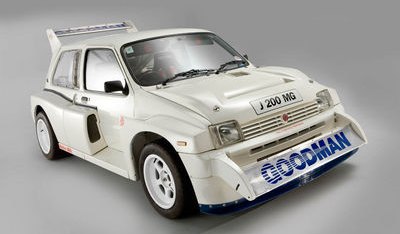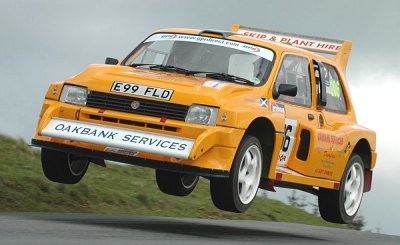 Group B rallying caught a
lot of interests from manufacturers in the mid-1980s. Audi, Peugeot,
Lancia and Ford invested enormous money to develop some of the world's
most spectacular performance cars ever made, and built 200 road cars to
satisfy the homologation requirements. Even the cash-strapped British
Leyland (now known as Austin Rover to consumers) could not resist the
temptation. The result was this Metro 6R4, whose name meant 6-cylinder,
Rally and 4-wheel drive.
It must be said that the Metro 6R4 was not a true MG, even though it wore the octagon logo. Since the demise of MGB and its historic Abingdon factory, the MG brand became no more than a badge stuck on selected Austin Rover bread-and-butter models, including the Metro mini car on which British Leyland decided the rally car was to be based. As the company lacked the necessary resources and expertise, it commissioned the engineering arm of Williams Grand Prix team to carry out the development. Its F1 designer Patrick Head oversaw the work while ex-Cosworth man David Wood was hired to develop a brand-new 3-liter all-alloy DOHC 24-valve V6 codenamed "V64V". This means it was the only Group B car favouring a large naturally aspirated engine instead of small turbocharged four. Nevertheless, the development of the new engine took time. As an interim solution, a 12-valve ohv V6 was created by chopping two cylinders off a Rover 3.5-liter V8. It was installed on a mock chassis to test the 4WD system. Somehow, motoring press confused it with the V64V and many incorrectly reported that the production V6 was derived from Rover V8!  Like Peugeot 205T16, Lancia Delta S4 and Ford RS200, the
Metro 6R4
selected mid-engined and 4WD layout for optimum balance and
roadholding. The V6 was mounted longitudinally behind the cockpit.
Sitting fore of the engine and inside the transmission tunnel were the
5-speed transmission and Ferguson viscous-coupling center differential,
which normally split 35 and 65 percent torque to the front and rear
LSD,
respectively. The rear differential sat beside the engine and was
integral with
the engine sump casting. By offsetting the whole powertrain slightly to
the left, equal-length half-shafts could be used.
The chassis shared virtually nothing with the production Metro, save the doors and some inner panels. Roll cage was added to cockpit while the rear half of the car was converted to a tubular spaceframe structure on which the powertrain and rear suspension were mounted. All four corners were suspended by heavy-duty MacPherson struts and lower wishbones. Suspension travel was increased so much that it called for a pronounced bonnet to house the tall suspension towers. Most of the exterior body panels were made of glass-fiber, including the pronounced fenders, side air box (which drew air to the side-mounted radiators), spoilers, bonnet and tailgate, whereas the roof was aluminum. The majority of the 200 cars built were finished in road specifications dubbed "Clubman". The remaining 20 or so cars were race-ready "International" spec. Their main difference was the engine tuning – the Clubman produced 250 hp and 225 lbft of torque, while the race car employed higher compression (12:1 instead of 11.5:1), faster cams, individual throttle butterfly and hotter ECU mapping to liberate up to 410 hp and 270 lbft. Besides, the race car had its glass-fiber exterior parts replaced with Kevlar ones to save weight. Otherwise both versions were more or less the same. Unlike the road version of Peugeot 205T16 and Lancia Delta S4, the Metro 6R4 Clubman was very close to race specifications. It even offered an upgrade kit for buyers to convert the car into International spec.  How did the 6R4 perform in the real world? Autocar magazine
conducted a road test in 1986 on both the road and race versions and
found they were very quick. The Clubman took merely 4.5 seconds to go
from 0-60 mph, faster than supercars like Ferrari 288GTO and
Lamborghini Countach QV. No doubt its combination of low weight (just
over 1 ton), short gearing and 4-wheel traction contributed to such a
good
result. 0-100 mph took 12.8 seconds, again a very quick number
considering the car's gearing and 0.48 Cd would not allow it to run
much beyond 110 mph. The race car was even more staggering, completing
0-60 and 0-100 mph in 3.2 and 8.2 seconds respectively!
However, to drive the car was not as good. As found out by another British publication, Motor, the 6R4 road car was as difficult to drive as an old-school 911, blame to its rearward weight bias and short wheelbase. It understeered a lot into corner, yet it would turn into big oversteer should you lift off throttle mid-corner. Correction was made difficult by the heavy unassisted steering. The only way to tame it was to drive as smoothly and tidily as possible, avoiding sudden and big actions. Judging by road car standards, the Metro 6R4 was terrible. Its ride was rock hard as the generous suspension travel was designed to deal with the heavy duty of rallying. The cabin was deafening noisy as it shared the same space with the engine without any sound insulation. After all, this car was designed to work as the basis of race car, so comfort and practicality was not a consideration. As a race car, the 6R4 also failed to deliver. Its best WRC result was just a third place in RAC 1986, which was its debut race. In the rest of the season it was usually hampered by reliability issues. Following a string of fatal accidents, FISA axed Group B rallying after that year. The 6R4 had no more chance to demonstrate the competitiveness of naturally aspirated car at the highest level. This doesn't mean the non-turbo experiment failed. In fact, without much financial backing, it had no reason to succeed. |